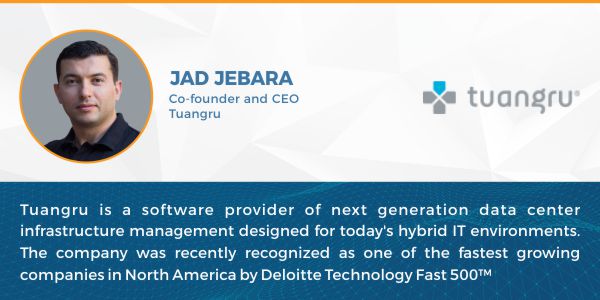



Feature Story
More feature stories by year:
2024
2023
2022
2021
2020
2019
2018
2017
2016
2015
2014
2013
2012
2011
2010
2009
2008
2007
2006
2005
2004
2003
2002
2001
2000
1999
1998
 Return to: 2018 Feature Stories
Return to: 2018 Feature Stories
CLIENT: TUANGRU
Apr. 7, 2018: ReadITQuik

Jad Jebara, Co-founder and CEO, Tuangru shares how the concept of all workloads residing in a physical data center is shifting fast, and explains how everything is moving towards Hybrid IT environments.
With hybrid IT's promise of increased efficiencies and cost savings, comes greater complexity. Tuangru's hybrid IT infrastructure management software lets you manage and monitor assets across on-prem, cloud, colocation, edge data centers—wherever your application workloads reside—in a single, easy-to-use platform.
"Our vision is to enable economic performance, reduce environmental impact, and enhance social equity of critical infrastructure, and our mission is to make critical infrastructure think."
Hybrid IT infrastructure (or hybrid cloud) is used when an enterprise has application workloads, both, on-premises in a data center and in the public cloud. This model is growing in adoption, the main drivers being a much lower total cost of ownership (TCO) and far higher efficiency. In fact, Gartner expects 90 percent of enterprises to adopt hybrid IT infrastructure by 2020. Our software empowers enterprises to manage this complex IT infrastructure model and realize the expected cost savings.
Having data-driven management tools to guide decisions is the best way to reside within your IT infrastructure. When looking at cloud, it's important to continually right-size workloads at the right cost to maintain the lowest TCO. Adopting a multi-cloud strategy aligns with this, as well as, avoids vendor lock-in.
Hybrid IT infrastructure (or hybrid cloud) is used when an enterprise has application workloads, both, on-premises in a data center and in the public cloud. This model is growing in adoption, the main drivers being a much lower total cost of ownership (TCO) and far higher efficiency. In fact, Gartner expects 90 percent of enterprises to adopt hybrid IT infrastructure by 2020. Our software empowers enterprises to manage this complex IT infrastructure model and realize the expected cost savings.
In one word, yes.
"Going all into the public cloud can prove to be disastrous. We've come across many companies who have done so, only to regret the decision due to skyrocketing costs, loss of control and/or compliance issues"
Hewlett Packard Enterprise has recently been talking about enterprises that are now running up against a "cloud cliff", an over-reliance on the public cloud leading to performance, cost, or control issues. This is one of the main drivers for adopting a hybrid IT infrastructure strategy.
No. As mentioned earlier, for certain workloads, private clouds can prove to be far more economical and provide greater control. That is why it is important to leverage hybrid IT management software to get data-driven recommendations.
Today's CIO is continually being tasked to reduce the total cost of ownership of infrastructure, as well as, be operationally-efficient, and greener for that matter.
"Our software allows CIOs to achieve these cost-saving and operational efficiency goals by removing the complexity associated with managing many workloads across a multi-sourced environment."
The adoption has been very slow. So slow, the federal government has launched the Data Center Optimization Initiative (DCOI) to effectively shut down and/or collapse existing legacy infrastructure into fewer more efficient facilities, and outsource the rest to the cloud. They have missed their targets twice now, however, I do see a big shift over the next 10 years towards more efficient hybrid IT environments.
A hybrid IT strategy provides the maximum flexibility for today's enterprise for the simple fact that you are not locked into a single-sourced infrastructure. Having the freedom to match workloads to the right infrastructure to achieve the lowest overall TCO is an enduring strategy.
Recently, we added the ability to manage our multi-cloud instances in Amazon Web Services, Microsoft Azure and Google Cloud. We will continue to build on this feature in 2018 with more robust tools to help determine which workloads to keep on-prem and which ones to migrate to the cloud.
Return to: 2018 Feature Stories